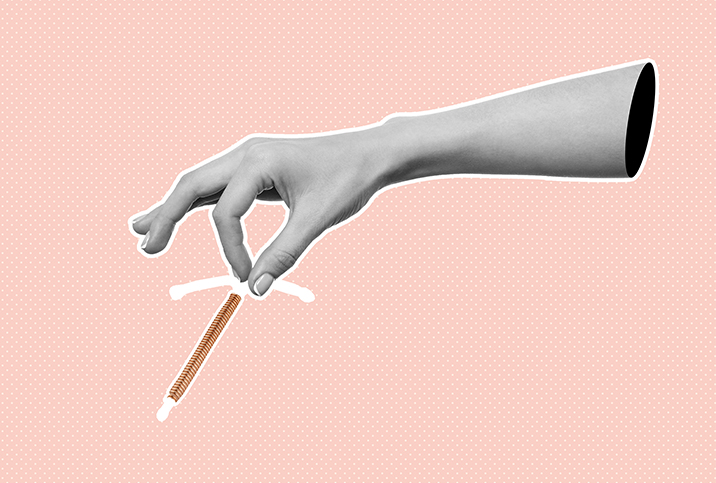The Ins and Outs of IUDs

Intrauterine devices (IUDs) are the second-most popular reversible form of birth control. IUD use has skyrocketed. In 2002, a mere 1.8 percent of women used IUDs, but by 2021, that figure had climbed to 13 percent.
What is an IUD?
An IUD is a form of contraception. It's a T-shaped device that is placed inside the uterus to prevent pregnancy, said Kecia Gaither, M.D., M.P.H., board-certified in OB-GYN and maternal-fetal medicine and director of perinatal services/maternal-fetal medicine at NYC Health + Hospitals/Lincoln in the Bronx in New York City.
There are two types of IUDs, copper and hormonal. Both types sit inside the uterus and prevent sperm from reaching the egg but have slight differences.
"The copper in a copper IUD is noxious to sperm, whereas the hormonal IUD releases progestin to thicken the layer of cervical mucus, which blocks and traps sperm and, thus, prevents ovulation," Gaither said.
FAQs about IUDs
This form of contraception isn't new. The copper IUD, under the brand name ParaGard, received U.S. Food and Drug Administration (FDA) approval in 1984 and became available in the United States in 1988.
Hormonal IUDs followed, with Mirena (2000), Skyla (2013), Liletta (2015) and Kyleena (2016) brands.
How effective is an IUD?
IUDs have proved highly effective at preventing egg fertilization and pregnancy. According to Planned Parenthood, they are more than 99 percent effective. Once an IUD is inserted, it's always working. You will never forget to use it and it can't malfunction.
These birth control devices can be effective emergency contraceptives. If inserted up to five days after unprotected sex, they can prevent up to 99.9 percent of pregnancies, however, they do not protect against sexually transmitted infections (STIs).
Are there any side effects of using an IUD?
As with any contraceptive, there may be side effects, though they are typically mild with hormonal IUDs. Speak with your doctor to determine if an IUD suits you.
The hormonal IUD releases low levels of progestin, which can lead to hormone-related side effects, Gaither said. These effects include:
- Headaches
- Breast tenderness
- Mood swings
- Acne
Both the hormonal and the copper IUD can cause:
- Irregular bleeding in around 15 percent of IUD users, but it typically decreases over time.
- Cramps and pelvic pain during insertion or up to a week after insertion.
- An increased risk of pelvic inflammatory disease (PID)
How long can I leave an IUD in my uterus?
IUDs are long-lasting but do have an expiration date, thus, you can't leave your IUD in your uterus forever. IUDs are effective for between three and 12 years, depending on its type.
The different IUDs and their longevity include:
- ParaGard. Lasts up to 10 years
- Mirena and Liletta. Up to eight years
- Kyleena. Up to five years
- Skyla. Up to three years
You may have your IUD removed by your healthcare provider anytime you want.
Which IUD is best for me?
While both hormonal and copper IUDs prevent pregnancy by making the uterus inhospitable for sperm, there are several reasons you may prefer one option over the other.
If you wish to avoid hormone-altering birth control, you may opt for the copper coil. On the other hand, the copper coil has been shown to be slightly less effective (99.2 percent) than the hormonal IUD (99.8 percent).
The copper coil can also lead to heavier and more painful periods for three to six months after initial insertion.
Skyla, Kyleena and Mirena often have unexpected potential health benefits. They can reduce cramps and their severity and help ease heavy bleeding. Some women don't get periods at all while on the hormonal IUD.
What should I expect from my IUD insertion?
Your gynecologist inserts the IUD. Some doctors schedule the insertion appointment during your menstrual cycle so your cervix is slightly more dilated. It's a fast process.
"An instrument called a tenaculum is utilized to place a bit of traction on the cervical lip, a uterine sound is utilized to assess the depth of the uterine cavity, and the IUD is inserted up the cervical canal into the uterus," Gaither said. "It is helpful if the patient takes an NSAID [nonsteroidal anti-inflammatory drug] prior to the procedure. Alternatively, a cervical block can be utilized to decrease the pain. Removal entails grasping the threads with ring forceps and pulling it out. If resistance is met, it may have to be removed hysteroscopically."
IUD insertion can be uncomfortable or painful. In some cases, painkillers can help to reduce pain during insertion. Insertion should take only around five minutes.
What happens after my IUD is inserted?
IUDs are immediately effective. But there is aftercare involved, Gaither said.
Take care of your body following your IUD insertion by:
- Not inserting anything, including tampons and bathwater, into the vagina for the first 48 hours.
- Avoiding high-intensity activity for about 24 hours after insertion.
- Examining your cervix a few days after your appointment to ensure the string remains. You'll learn about this process during your insertion appointment.
- Remembering that a copper coil may cause heavier periods with cramping.
- Remembering that inserting either type of IUD can cause temporary pelvic pain.
Is there any maintenance required?
There is no regular maintenance required with IUDs. However, if you experience ongoing pain, extremely heavy bleeding or discomfort, or notice changes in the strings at the cervix, call your doctor.
Can an IUD get lost in the uterus?
It is rare for an IUD to move around in your uterus. In some cases, an IUD can fall out or be expelled, though it's a rare occurrence.
People with fibroids are more likely to experience expulsion.
A uterine perforation, when an IUD becomes stuck in the uterine walls, occurs in roughly 1 of every 1,000 insertion procedures. A perforation can lead to severe pain and possible surgery to remove the IUD.
Is there anyone who shouldn't get an IUD?
IUDs are typically safe for most people. IUD complications occur in fewer than 1 percent of people.
Preexisting conditions or illnesses that don't work well with an IUD can include:
- Blood clots
- PID
- Diabetes
- Anemia
- Ovarian cancer
- Vaginal infection
- Abnormally placed uterus
Always speak to your doctor about your medical history before getting an IUD to ensure it's a safe option for you.
The bottom line
An IUD is a convenient form of birth control because it can benefit people who have heavier periods or don't want to remember to take medication. Weigh your options with your doctor.
If you don't have a healthcare professional, try Giddy Telehealth. The easy-to-use online portal takes the difficulty out of finding a new doctor. Finding a new doctor is a snap, with hundreds of medical professionals to choose from, including many with same-day appointments.


















